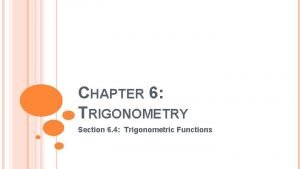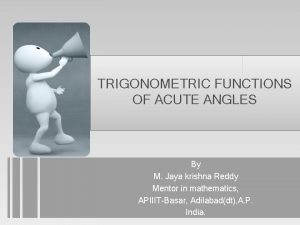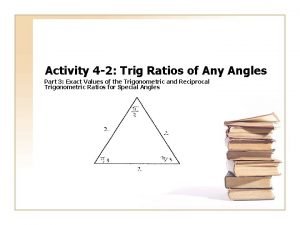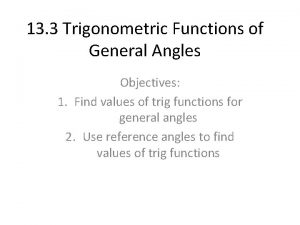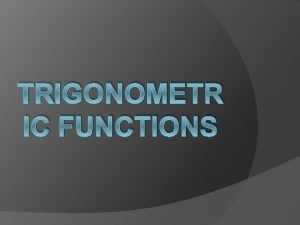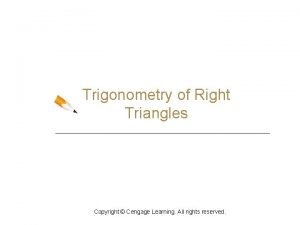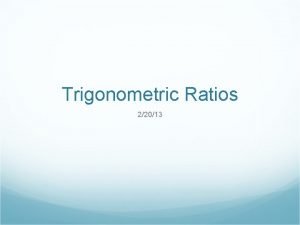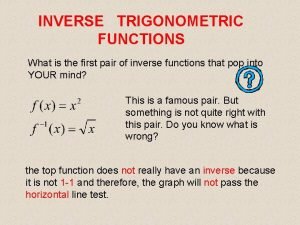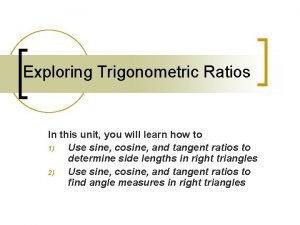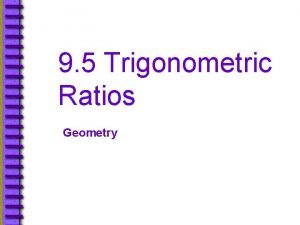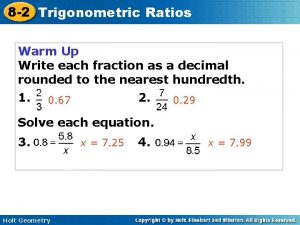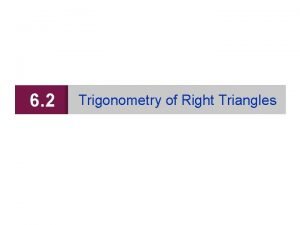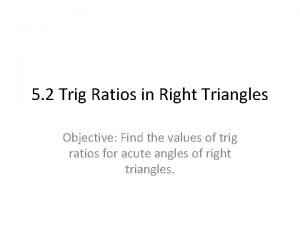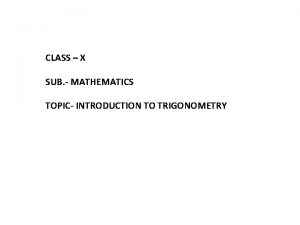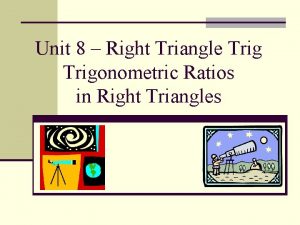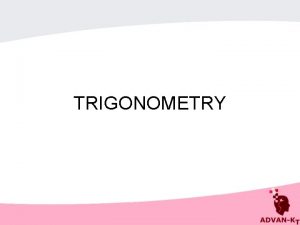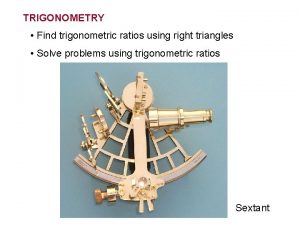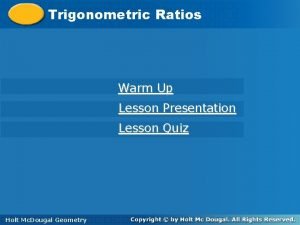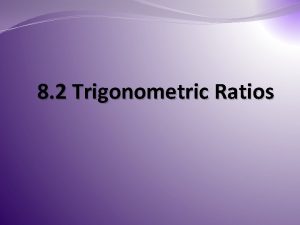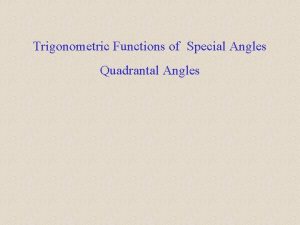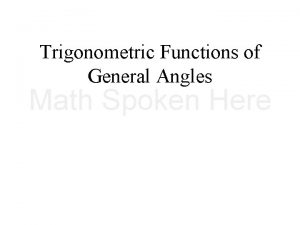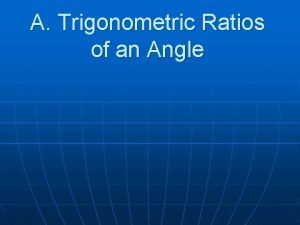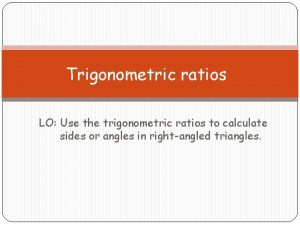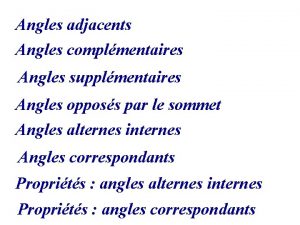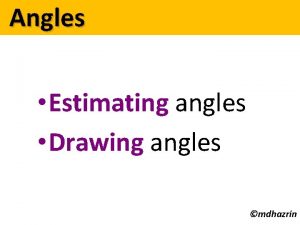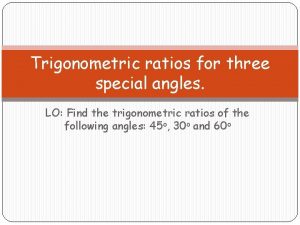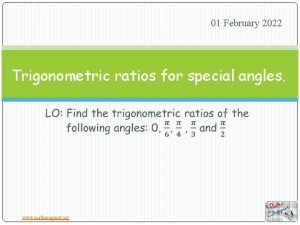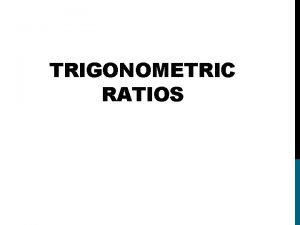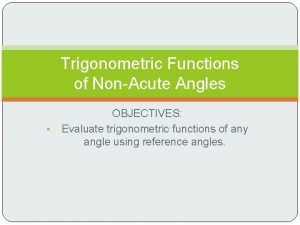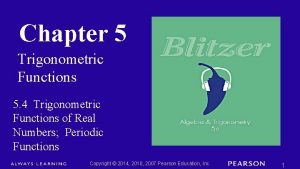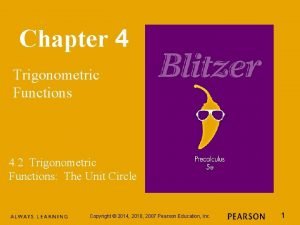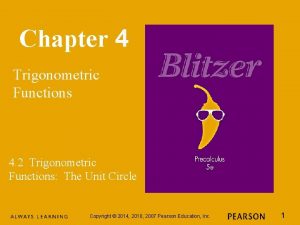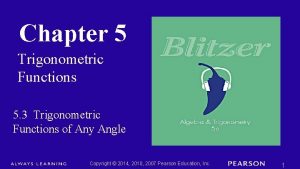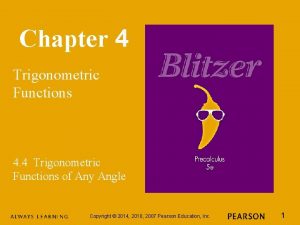Chapter 10 Trigonometric Functions Trigonometric Ratios Special Angles





















- Slides: 21

Chapter 10 Trigonometric Functions Trigonometric Ratios Special Angles Trigonometric Ratios of any angles

The Trigonometric Functions we will be looking at SINE COSINE TANGENT

Greek Letter Prounounced “theta” Represents an unknown angle

Angle Measures and Types of Angles • The most common unit for measuring angles is the degree. (One rotation = 360 o) • ¼ rotation = 90 o, ½ rotation = 180 o, • Types of angles named on basis of measure:

Basic Terms continued • Positive angle: The • Negative angle: The rotation of the terminal side of an terminal side is angle counterclockwise.

hypotenuse adjacent opposite

Find the values of the three trigonometric functions of . ? 5 4 3 Pythagorean Theorem: (3)² + (4)² = c² 5=c

Trigonometric Ratios of Special Angles • The trigonometric ratios of angles measuring 30 o, 45 o and 60 o can be obtained using a square and an equilateral triangle.

Complementary and Supplementary Angles • Two positive angles are called complementary if the sum of their measures is 90 o • The angle that is complementary to 43 o = • Two positive angles are called supplementary if the sum of their measures is 180 o • The angle that is supplementary to 68 o =

Positive Trig Function Values STUDENTS Sine and its reciprocal are positive ALL y -y r r -x y All functions are positive x r TAKE Tangent and its reciprocal are positive r -y CALCULUS Cosine and its reciprocal are positive

Positive, Negative or Zero? sin 240° Negative cos 300 o Positive tan 225 o Positive

Determine the Quadrant In which quadrant is θ if cos θ and tan θ have the same sign? Quadrants I and II

Determine the Quadrant In which quadrant is θ if cos θ is negative and sin θ is positive? Quadrant II

Using the Sign If and θ lies in Quadrant III, find sin θ and tan θ -1 θ -√ 3 2

Reference Angles Reference Angle or Basic Angle: the smallest acute angle determined by the x-axis and the terminal side of θ ref angle Think of the reference angle as a “distance”—how close you are to the closest x-axis.

Reference Angles A reference angle is the acute angle formed by the terminal side of and the horizontal axis. Find the reference angles of 300 o and – 135 o. 300 o 60 o 45 o -135 o

Find Reference Angle 150° 30° 225° 45° 300° 60°

Using Reference Angles a) sin 330° = = - sin 30° = - 1/2 b) cos 120° = = - cos 60° =-½

Using Reference Angles c) sin (-120°)= = - sin 60°

Finding Exact Measures of Angles • Find all values of • Sine is negative in Q III and Q IV • Using the 30 -60 -90 values we found earlier, we know

Finding Exact Measures of Angles – Cont. • • Our reference angle is 60 o. We must be 60 o off of the closest x-axis in Q III and QIV.
 Six trigonometric functions of special angles
Six trigonometric functions of special angles Trigonometric ratios of the angles
Trigonometric ratios of the angles Trig ratios for special angles
Trig ratios for special angles Properties of vertically opposite angles
Properties of vertically opposite angles Trig functions of general angles
Trig functions of general angles Trigonometr
Trigonometr Example of six trigonometric ratios
Example of six trigonometric ratios Triangle congruence review maze answer key
Triangle congruence review maze answer key What is a trigonometric ratio
What is a trigonometric ratio Inverse trig function calculator
Inverse trig function calculator Sine ratio
Sine ratio Sin 30
Sin 30 8-2 trigonometric ratios worksheet answers
8-2 trigonometric ratios worksheet answers Magic triangles trigonometry
Magic triangles trigonometry Sohcahtoa jokes
Sohcahtoa jokes Trigonometry ratios worksheet
Trigonometry ratios worksheet How to remember trigonometric ratios
How to remember trigonometric ratios Types of trigonometric ratios
Types of trigonometric ratios Trigonometric ratios in right triangles
Trigonometric ratios in right triangles Circle quadrants
Circle quadrants Magic triangle trigonometry
Magic triangle trigonometry Zishyp
Zishyp
